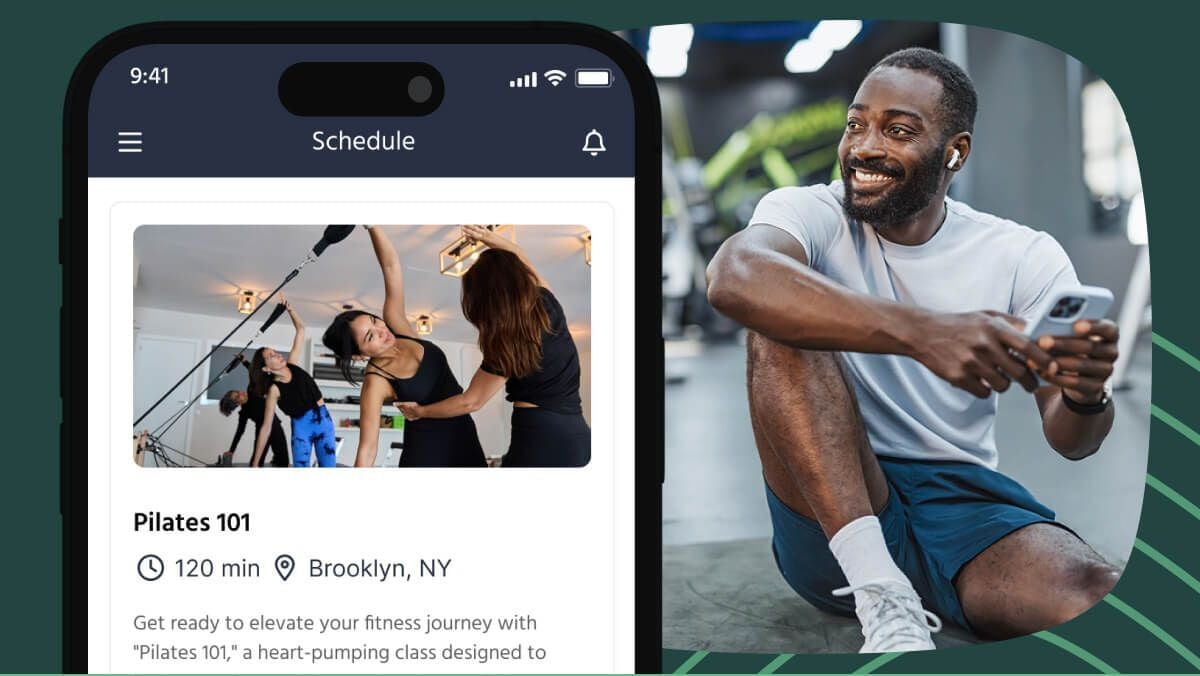When managing a fitness business, precise planning, a client-centric approach, and an unwavering commitment to excellence are critical.
As a fitness business owner, you wear multiple hats. From overseeing daily operations to strategizing growth plans, your role is pivotal in shaping the success of your enterprise.
Your business' success relies on your ability to deliver exceptional fitness services and your capacity to run a seamless operation, ensuring profitability, employee satisfaction, and customer loyalty.
This article will provide the 13 Best Tips for Managing a Fitness Business, crafted specifically to guide you on this journey. Let's dive into the strategies and practical advice that can help you elevate your fitness business to new heights.
Find the best ways to use customer reviews
to grow your business
DOWNLOAD NOW 
1.Use management software
Management software is a comprehensive tool designed to handle various aspects of your business, such as scheduling, memberships, billing, and reporting. It simplifies your day-to-day operations, allowing you to focus more on other crucial aspects, such as improving your services or expanding your business.
2. Create a memorable brand
A memorable brand is not merely about having a catchy name or a striking logo. It's about creating a unique and consistent experience that resonates with your audience and communicates your core values and USP.
Building a memorable brand is crucial in managing a successful fitness business. It can work wonders for your venture, fostering customer loyalty, differentiating you from competitors, and creating a strong identity that resonates with your target audience. But how do you create such a brand?
- Understanding your audience
Firstly, you need a deep understanding of your audience. Who are they? What are their fitness goals? What do they value in a fitness business? You can tailor your brand to meet their specific needs and desires by answering these questions.
- Developing a unique selling proposition (USP)
Your brand should communicate your Unique Selling Proposition (USP) - what makes you different and better than the competition. This could be anything from a specialized fitness program, unique workout techniques, or extraordinary customer service.
- Consistency is key
Consistency is a key element in branding. Every touchpoint should communicate your brand's core values and personality, from your logo and website to your interior design and customer interactions. This ensures that customers have a unified and seamless experience, reinforcing your brand in their minds.
- Engaging brand story
People connect with stories; a compelling brand story can create an emotional connection with your audience. This could be the story of why you started your fitness business or the transformation journey that your clients experience.
3. Build strong relationships with members
Establishing strong relationships with your fitness business members helps promote a positive and supportive environment. This approach has been proven to be a successful business strategy in the fitness industry.
Here are some effective strategies to build stronger connections with your members:
- Regular communication: Keep your members updated about any changes, new classes, or promotions. This can be through emails, social media, or in-person conversations.
- Individual attention: Make your members feel valued by acknowledging their efforts, progress, and achievements. One-on-one conversations help build rapport and show interest in their fitness journey.
- Feedback solicitation: Encourage members to provide feedback about your services. This feedback can be invaluable for improving your business and shows your members that their opinions matter.
- Community building: Organize events or classes that promote community among your members. This can include group classes, fitness challenges, or social gatherings.
4. Use social media effectively
Social media is about building relationships. Show the human side of your business, connect with your audience personally, and they'll be more likely to choose your services over your competitors.
Social media can attract new clients, promote your services, and create engagement within your community.
Identify the platforms where your potential customers hang out.
Instagram, Facebook, TitkTok, and YouTube can be excellent choices for most fitness businesses.
These platforms allow you to showcase your services, workout routines, and success stories in a way that’s visually appealing.
Here's a list of tips to manage your social media presence effectively:
- Plan your content: Develop a content calendar and stick to it. Consistency is key to keeping your audience engaged and coming back for more.
- Use visuals: Fitness is a visual industry. Use high-quality images and videos to showcase your services and results.
- Engage with your audience: Reply to comments, ask questions, and encourage your followers to interact with your posts.
- Use hashtags strategically: Hashtags can help your posts reach a wider audience. Use popular fitness hashtags, but also create your own unique ones to build brand recognition.
- Share success stories: Sharing client success stories can be a powerful tool to attract new customers and inspire existing ones.
5. Incorporate unique programs and services
Standing out in the fitness industry is crucial for the survival and growth of your business. Consider your clients’ needs and interests and how you can meet them in an innovative way.
This strategy will differentiate your fitness business from the competition, attracting new clients, retaining existing ones, and increasing revenue.
Here's how and why you should incorporate this strategy into your fitness business.
- Attract new clients: New and unique fitness programs can be an excellent marketing tool. By offering something different, you can attract customers looking for a unique fitness experience or those who haven't found success with other fitness regimes. For example, introducing a fitness program that combines yoga with high-intensity interval training can attract yoga enthusiasts and those who enjoy a more strenuous workout.
- Retain current clients: Introducing new services and programs keeps your existing members engaged and interested, reducing their chances of leaving for a competitor. For instance, offering nutritional counseling or physiotherapy services can add value to your clients' membership and encourage them to renew.
- Increase revenue: Unique services or programs often come with an additional cost, providing an extra revenue stream for your business. You can offer these specialized services as part of a premium package or pay-per-use basis.
However, there are a few things to keep in mind when introducing new programs or services:
- Ensure you properly assess the new service's demand and profitability before implementing it.
- Ensure you have the necessary resources, such as skilled staff and equipment, to offer the new service.
- Promote the new service effectively to your current and potential clients.
6. Manage finances efficiently
Efficient financial management is a cornerstone for the success of any fitness business. It involves more than just balancing the books. It's about making informed decisions based on data and understanding the financial health of your business.
Here's how you can manage your finances more efficiently:
- Understand your revenue streams: A fitness business typically earns from memberships, personal training, merchandise, and sometimes even in-house cafes. Understanding these streams will help you track your income and plan accordingly.
- Track expenses: Keeping a close eye on your fixed and variable expenses can help you manage your resources better. This could be anything from rent and utilities to staff salaries and equipment maintenance.
- Set financial goals: Clear, measurable goals can guide your business decisions. Whether increasing membership numbers or reducing operating expenses, having a goal in mind keeps you focused.
- Use software: Financial software can help streamline your financial processes, from billing and invoicing to payroll and tax preparation. It also minimizes the risk of human error.
- Create a financial contingency plan: A backup plan for emergencies is crucial. This could be a cash reserve or an arranged line of credit, which can be a lifesaver during unexpected downturns.
7. Stay up to date with industry trends
Staying up to date with industry trends allows you to adapt your business strategies to meet changing client needs and preferences. It also helps you stand out by offering unique and innovative services.
Staying updated about industry trends demonstrates your commitment to continuous learning and improvement, which can boost your reputation and customer trust.
How to Stay Up to Date:
- Subscribe to fitness magazines and blogs: These are often the first places where new trends emerge. They feature articles by fitness experts discussing the latest research findings and innovative workout techniques.
- Attend fitness conferences and workshops: These events offer information, from training sessions to keynote speeches by industry leaders. They also provide opportunities for networking and collaboration.
- Join professional associations: Industry-specific groups often provide resources and updates to their members. They also provide opportunities for professional development and networking.
- Follow social media influencers: Many fitness enthusiasts and professionals share their knowledge and insights on social media. Following them lets you stay informed about trending topics and popular workouts.
8. Provide excellent customer service
Exceptional customer service can transform an ordinary enterprise into a thriving hub of wellness and community. Satisfied customers are likely to be repeat customers and are your best referral source.
Exceptional customer service also sets you apart from competitors and fosters a sense of trust and loyalty among your clientele. So, how exactly can you provide excellent customer service in your fitness business?
Here are some key strategies:
- Understand your clients’ needs: Conduct surveys, or have informal chats to pinpoint what your clients expect from your services. Use this valuable feedback to tailor your business offerings and customer service approach.
- Communicate effectively: Keep your clients informed about changes in the schedule, new trainers, or facility improvements. Clear, timely, and transparent communication enhances client satisfaction and retention.
- Invest in trained staff: Your trainers and support staff are the face of your business. Ensure they are well-trained, courteous, and responsive to client needs.
- Deliver consistent service: Delivering consistent and high-quality service is crucial for maintaining your brand's reputation. Clients value consistency as it gives them a sense of reliability and trust in your services.
9. Build a strong online presence
A strong online presence increases your brand's visibility and allows you to engage with a broader audience, build trust, and drive more memberships.
As more individuals turn to online platforms to find fitness solutions, being prominently visible online ensures that potential clients can easily discover and connect with your services.
Here are some tips for building a strong online presence:
- Website creation: Start with a user-friendly, mobile-responsive website that showcases your services, class schedules, testimonials, and contact information.
- Social media engagement: Create profiles on popular platforms like Instagram, Facebook, and Twitter. Share workout tips, success stories, and live workout sessions to engage your audience.
- Online reviews: Encourage satisfied members to leave positive reviews on platforms like Google My Business and Yelp. This not only boosts your credibility but also improves local search rankings.
- Content marketing: Regularly publish blog posts or articles about fitness tips, nutrition advice, or industry trends. This positions your business as an authority in the fitness domain.
- Email marketing: Collect email addresses and send out newsletters, special offers, or updates to engage your members and potential clients.
Consider the success story of "Peloton", which leveraged its strong online presence to offer live streaming and on-demand classes, transforming how people perceived home workouts. Their consistent online engagement and quality content have made them a household name in the fitness industry. Similarly, local gyms and fitness centers can harness the power of the internet to reach and engage their audience, fostering loyalty and driving growth.
10. Keep your facility clean
Keeping your gym clean is super important for running a successful fitness business. When your gym is clean, it's more than just a good look. It means you're keeping everyone safe and healthy.
People feel more at ease and are more likely to return to a clean gym. It clearly shows that you value and care for your members and team.
Here's how you can keep things clean and why it matters:
- Clean often: Don't just clean every once in a while. Make sure to clean deeply at least once a month. This means cleaning all the equipment, floors, and bathrooms.
- Easy-to-find cleaning stuff: Put cleaning stations everywhere, especially near the machines and weights. Make sure they have things like wipes or sprays and hand sanitizers.
- Teach your team: Ensure everyone who works for you knows how to clean right. Give them a list of things to clean daily and show them how to do it.
- Tell your members: Ask everyone who comes to work out to clean the machines after they use them. Put up signs to remind them and have cleaning stuff nearby.
- Fresh air: Make sure your gym has good air coming in. Check the air filters and clean them so the air stays fresh and clean.
Think about when the COVID-19 pandemic started. Gyms that kept things clean and told everyone about it saw people returning faster. Big gyms like "Gold's Gym" and "Planet Fitness" even discussed how clean they kept things in their ads. So, keeping things clean isn't just about health; it's also good for business.
11. Develop a strong community
Building a strong community within a fitness business is crucial. It boosts member retention and transforms members into advocates for your brand.
To foster this community:
- Host group events or classes to encourage member interaction.
- Engage with members on social media, highlighting their achievements.
- Introduce a mentorship system, pairing new members with seasoned ones for guidance and support.
For example, CrossFit's global success is partly due to its tight-knit community. Members support and motivate each other, creating loyalty to the brand. Fitness businesses can achieve similar loyalty and growth by focusing on the community.
12. Stay passionate and motivated
Maintaining passion and motivation is essential in the fitness industry. It drives business growth, inspires teams, and attracts clients. To keep this enthusiasm alive:
- Reconnect with your why: Remember the reason you started your fitness journey. Reflecting on this can reignite your passion.
- Continuous learning: Stay updated with the latest in fitness. Attend workshops or webinars to gain new insights.
- Surround yourself with a passionate team: Having a team that shares your vision can uplift and motivate you during challenging times.
13. Improve your sales techniques
Improving sales techniques is essential for a fitness business to attract and retain members. Effective sales can differentiate your gym in a competitive market.
To enhance sales:
- Understand your target audience. Know what potential members want from a fitness center.
- Regularly train your team. Focus on clear communication, addressing customer needs, and effective closing techniques.
- Use technology, like CRM systems, to track interactions and ensure timely follow-ups.
- Offer experiences like virtual tours or trial classes to give potential members a taste of your services.
For instance, boutique fitness studios often succeed by highlighting their unique workouts and personalized attention, setting them apart from larger gyms. By clearly communicating these benefits, they attract dedicated members.
Frequently asked questions about managing a fitness business
What are the key parts of managing a successful gym business?
The key parts of managing a successful gym business include a well-thought business model, excellent customer service, skilled staff, efficient operational processes, constant marketing, and regular assessment of business performance.
What are some common challenges faced by fitness business owners?
Some common challenges fitness business owners face include maintaining consistent client engagement, managing overhead costs, and staying abreast of the latest fitness trends and technologies.
What are some effective marketing strategies for a fitness business?
Effective marketing strategies for a fitness business often include leveraging social media platforms, providing value through high-quality content, and fostering a community atmosphere. Maintaining a strong online presence and offering promotional deals are also beneficial.
How can I improve customer retention in my fitness business?
To improve customer retention in your fitness business, focus on personalizing customer experiences, providing excellent customer service, and consistently delivering high-quality fitness programs. Incentives like loyalty programs can also be beneficial.
What are some ways to stand out from competitors in the fitness industry?
To stand out from competitors in the fitness industry, prioritize offering distinct services, maintaining exceptional customer service, and keeping a tidy facility.
What are some tips for managing a team of personal trainers?
Managing a team of personal trainers involves clearly communicating expectations, fostering a collaborative environment, and regularly providing constructive feedback. Regular training and development opportunities can also ensure your team stays ahead in the fitness industry.
What are some ways to increase revenue in a fitness business?
Increasing revenue in a fitness business can be achieved by diversifying your service offerings, implementing a membership model, and optimizing your marketing strategies to attract a wider client base.
Find the best ways to use customer reviews
to grow your business
DOWNLOAD NOW 










